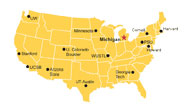Current display technologies are based on chemical colorant pigmentation, which are vulnerable to a variety of processing chemicals, cannot withstand constant illumination with strong light intensities, and require extensive multilayer processing to pattern individual pixels. An alternative display technology being researched involves the use of photonic and plasmonic crystal based structures as colour filters, which offer increased efficiencies of filtering, low power consumption, slim dimensions, and enhanced resolution. However, the iridescence of these structural colour designs based on photonic crystals and plasmonic nano-structures cause a drastic change in colour with different incident angles of light.
As an alternative to grating coupling, the use of plasmonic based resonators and antennas was explored to obtain greater angle independence. This project implements vertical plasmonic resonator arrays with specially designed periodicity to avoid angle variation which were used to increase the scattering efficiency to viewers’ eyes and generate more vivid colours. The design proposed here utilizes light funneling into nanoslits which are exploited to demonstrate near perfect absorption, as large as 96%, in the visible spectrum with plasmonic mode coupling comparable to that of grating coupling. Additionally, wide colour tunability throughout the entire visible spectrum and pixel size beyond the diffraction limit (~λ/2) are demonstrated. A design principle for angle-robust reflection by investigation of angular response of the reflection spectra with respect to the periodicity of arrayed one-dimensional structures is suggested. The ultra-high resolution, widely tunable colour filtering is achieved through adjusting the dimensions of the groove depth. The grooves can be adjusted to provide the colors of yellow, cyan, and magenta by altering only the depth of the groove or the width of the groove while keeping the period and the other dimension constant, which provides the wide color tunability. An example of the visual performance of this technique is show in figure 1 to the right, where this method was employed to create Olympic rings of varying colour with figures inside, through varying the width of the grooves only. This shows the ultra-high resolution possible as well as an example of the color tunability  of the device. The angular dependence of these images was measured only up to 30 degree because of the small size of the structure and the limitation of the optical path in the microscope. Within this range, the color appears unchanged. This is an example of the type of performance possible from this approach, which has multiple practical applications. To read more on this exciting research being conducted at the Lurie Nanofabrication Lab at the University of Michigan, visit the link below to view the full article.
of the device. The angular dependence of these images was measured only up to 30 degree because of the small size of the structure and the limitation of the optical path in the microscope. Within this range, the color appears unchanged. This is an example of the type of performance possible from this approach, which has multiple practical applications. To read more on this exciting research being conducted at the Lurie Nanofabrication Lab at the University of Michigan, visit the link below to view the full article.
Figure 1: Colour demonstrations with ultra-high
resolution and polarization dependent images.
Yi-Kuei Ryan Wu, Andrew E. Hollowell, Cheng Zhang, L. Jay Guo
Work performed in the U Michigan Lurie Nanofabrication Lab
Scientific Reports 3, 1194, 01 February 2013
Full article can be viewed at: http://www.nature.com/srep/2013/130201/srep01194/full/srep01194.html



